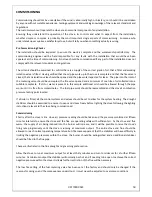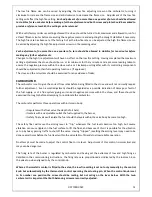
C07100DC023
54
To provide the stove with fuel at the correct pressure it will be necessary to have the tank outlet at the maximum
3 meters (118 inches) above the stove’s metering valve top. The hightest fuel level must never be allowed to
exceed 3 meters above the valve top. If these limits cannot be achieved a secondary reservoir with a lift pump or
level control valve must be fitted. You will need to refer to the relevant building regulations and local bye-laws
for any restrictions on tank position relative to buildings and boundaries together with the provision of barrier
walls that may exist in your area.
Whatever type of tank you fit it must be equipped with two outlets, one to supply the stove and one at the
opposite end through which to drain off any accumulation of dirt or condensate from the tank. To facilitate this
the tank must be mounted to allow a fall, away from the stove outlet end and towards the drain, of 0.8 inches for
every 1 meter of tank length.
If a metal tank is installed it may be supported on brick piers insulated from the tank with a waterproof
membrane. A polyethylene tank must be supported over its entire base area.
Do not underestimate the weight of a full oil tank, it is heavy and must be supported with adequate foundations
and plinth. All cemented support must be allowed sufficient time to cure before fitting the tank.
Tank Fittings and Pipework
An isolating valve must be fitted directly to the tank outlet, allowing for the maintenance of the other
components in the pipeline. These components should include a metal bowl oil filter mounted to allow adequate
room for the removal of the sediment bowl and filter element without difficulty. The filter element should be
cleaned or replaced at least annually. We do not advise the fitting of plastic bowl oil filters as we consider them
too fragile for outdoor, unprotected situations.
Whilst the pipework from the tank to the stove may be in either steel or copper, the fitting of steel pipe
necessitates regular maintenance, therefore, the use of plastic covered copper pipe is recommended because it is
easily installed and virtually maintenance free. The use of galvanised steel pipe is prohibited because zinc reacts
with the fuel.
Where it is possible it may be desirable to bury the pipe, and whilst this is perfectly acceptable it must be done
with the utmost attention to the protection of the pipe from damage, both during the installation and throughout
its life, as it will not be possible to make inspections for leaks after installation.
Before the pipeline enters the building a fire valve should be fitted which will cut off atomatically the oil supply in
the unlikely event of the stove overheating. This valve is controlled by a remote sensing element situated within
or near the stove and above the metering valve. Finally, another manual isolation valve should be positioned as
close to the stove as possible to enable all supply to be turned off for stove maintenance.
It is possible to bury oil tanks, install them in house cellars and end oil pipework over a tortuous route of many
hundreds of yards, but any oil installation other than the most simple should be attempted only by suitably
qualified and experienced personnel, with the written approval of your insurance company.
Summary of Contents for H11
Page 1: ...MAZOUT OLIE OIL MODE D EMPLOI GEBRUIKSAANWIJZING INSTALLATION AND OPERATING INSTRUCTIONS ...
Page 2: ...C07100DC023 1 ...
Page 52: ...C07100DC023 51 FLUE CONNECTION IDEAL TO BE AVOIDED ...
Page 53: ...C07100DC023 52 IDEAL TO BE AVOIDED ...
Page 56: ...C07100DC023 55 ...
Page 76: ...C07100DC023 75 ...
Page 77: ...C07100DC023 76 SOTO DE LA MARINA CANTABRIA Apdo de correos 208 SANTANDER C07100DC023 04 2017 ...
















































